Computational materials theory research group
Atoms, electrons, symmetry, geometry
 Sinisa Coh, sinisa.coh@ucr.edu
Sinisa Coh, sinisa.coh@ucr.edu
Associate Professor
University of California, Riverside We are a computational materials research group at the University of California, Riverside working on nanostructured materials, complex oxides, layered materials, magnetic materials, topological insulators, superconductors, and optical properties of real materials. We design, discover, and characterize functional materials using state of the art computational techniques, symmetry, nearsightedness principles, geometry, and topology.
Join us
If you would like to join computational materials theory research group, send an email to sinisa.coh@ucr.edu. Please contact Sinisa Coh if you are either currently a graduate or undergraduate student at UCR, or are planning to join UCR in the near future in either materials science, mechanical engineering, or physics.
Contact information
Email: sinisa.coh@ucr.edu
Office: Bourns Hall room A323
Phone: (951) 827-3375
Research publications
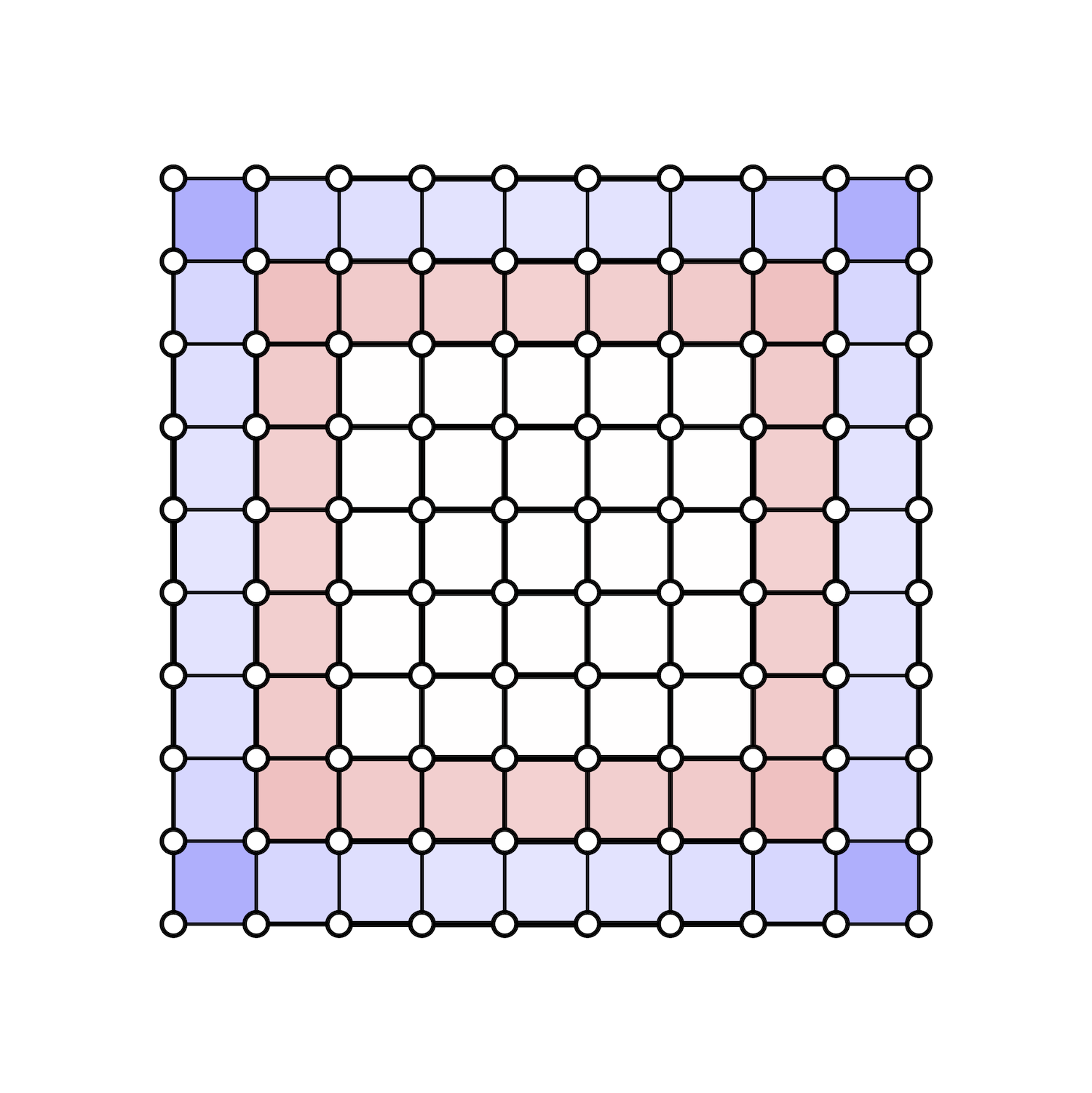 We find that in the mesoscopic regime modification of the material's surface can induce an extensive change of the material's magnetic moment. In other words, perturbation of order N2 atoms on the surface of a 3-dimensional solid can change the magnetic moment proportionally to N3.
We find that in the mesoscopic regime modification of the material's surface can induce an extensive change of the material's magnetic moment. In other words, perturbation of order N2 atoms on the surface of a 3-dimensional solid can change the magnetic moment proportionally to N3.
54. Phys. Rev. B 109, 174431 (2024)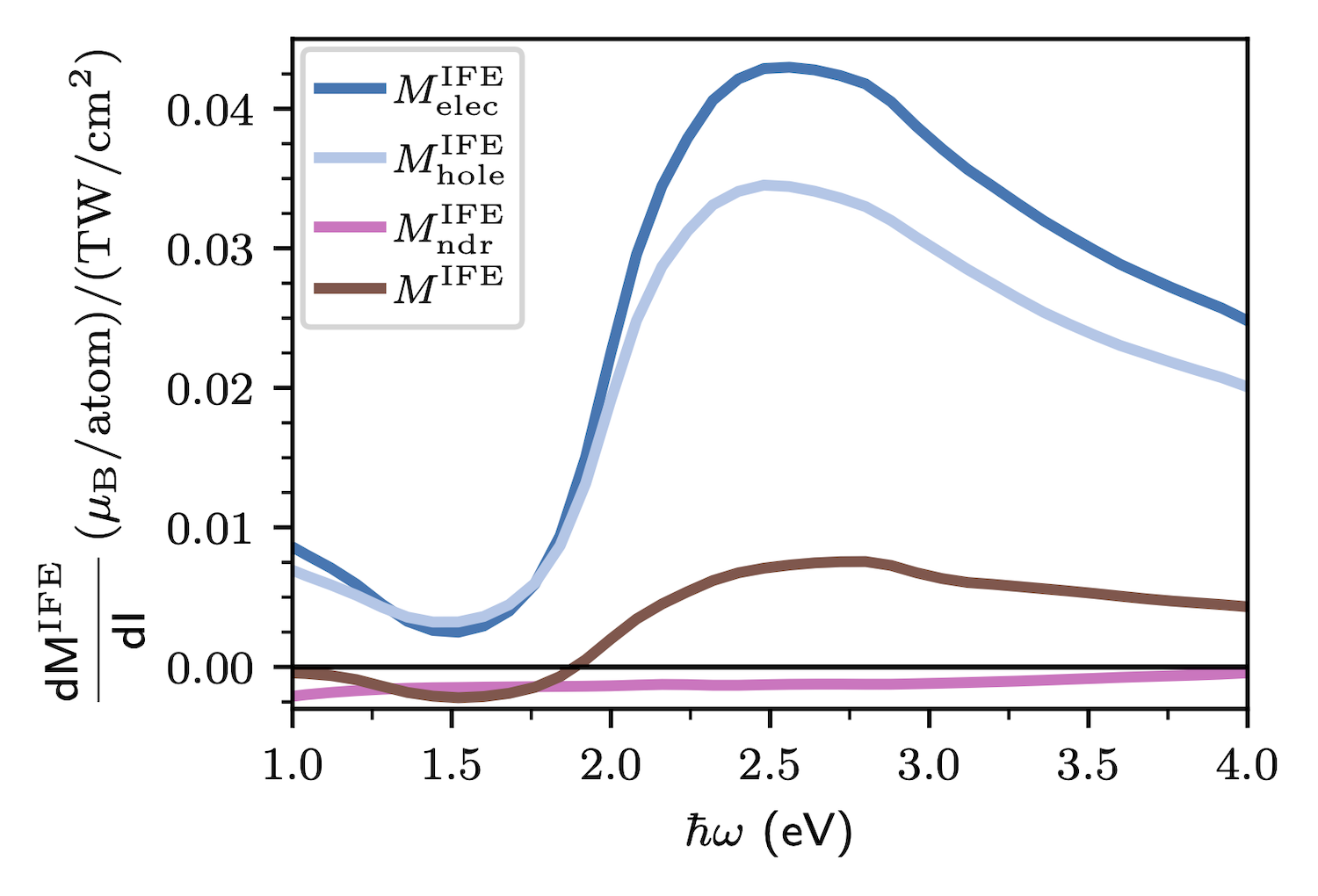 We formulate the spin contribution to the inverse Faraday effect of nonmagnetic metals. We deal with the role of the inversion symmetry, which forces all electronic bands to be at least twice degenerate at every point in the Brillouin zone.
We formulate the spin contribution to the inverse Faraday effect of nonmagnetic metals. We deal with the role of the inversion symmetry, which forces all electronic bands to be at least twice degenerate at every point in the Brillouin zone.
50. Phys. Rev. B 107, 214432 (2023) We find that in BaTiO3 the phonon angular momentum is dominantly pointing in directions perpendicular to the electrical polarization. Therefore, external electric field in ferroelectric BaTiO3 does not control only the direction of electrical polarization, but also the direction of phonon angular momentum.
We find that in BaTiO3 the phonon angular momentum is dominantly pointing in directions perpendicular to the electrical polarization. Therefore, external electric field in ferroelectric BaTiO3 does not control only the direction of electrical polarization, but also the direction of phonon angular momentum.
45. Phys. Rev. Materials 6, 104410 (2022)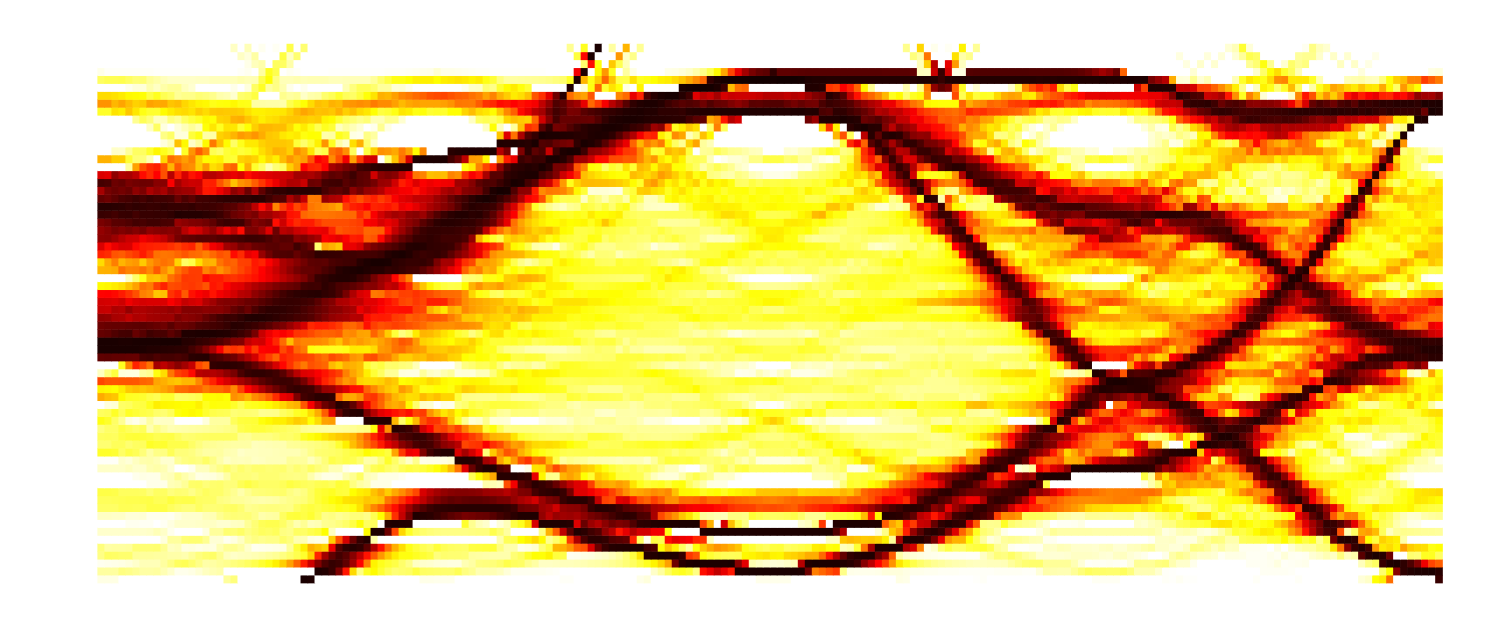 We computed the thermoreflectance spectra of Au from first principles. Our calculations confirm that phonon temperature dominates thermoreflectance of Au. Most of thermoreflectance is due to the effect of the phonon population on electron lifetime.
We computed the thermoreflectance spectra of Au from first principles. Our calculations confirm that phonon temperature dominates thermoreflectance of Au. Most of thermoreflectance is due to the effect of the phonon population on electron lifetime.
42. Phys. Rev. Materials 5, 106001 (2021)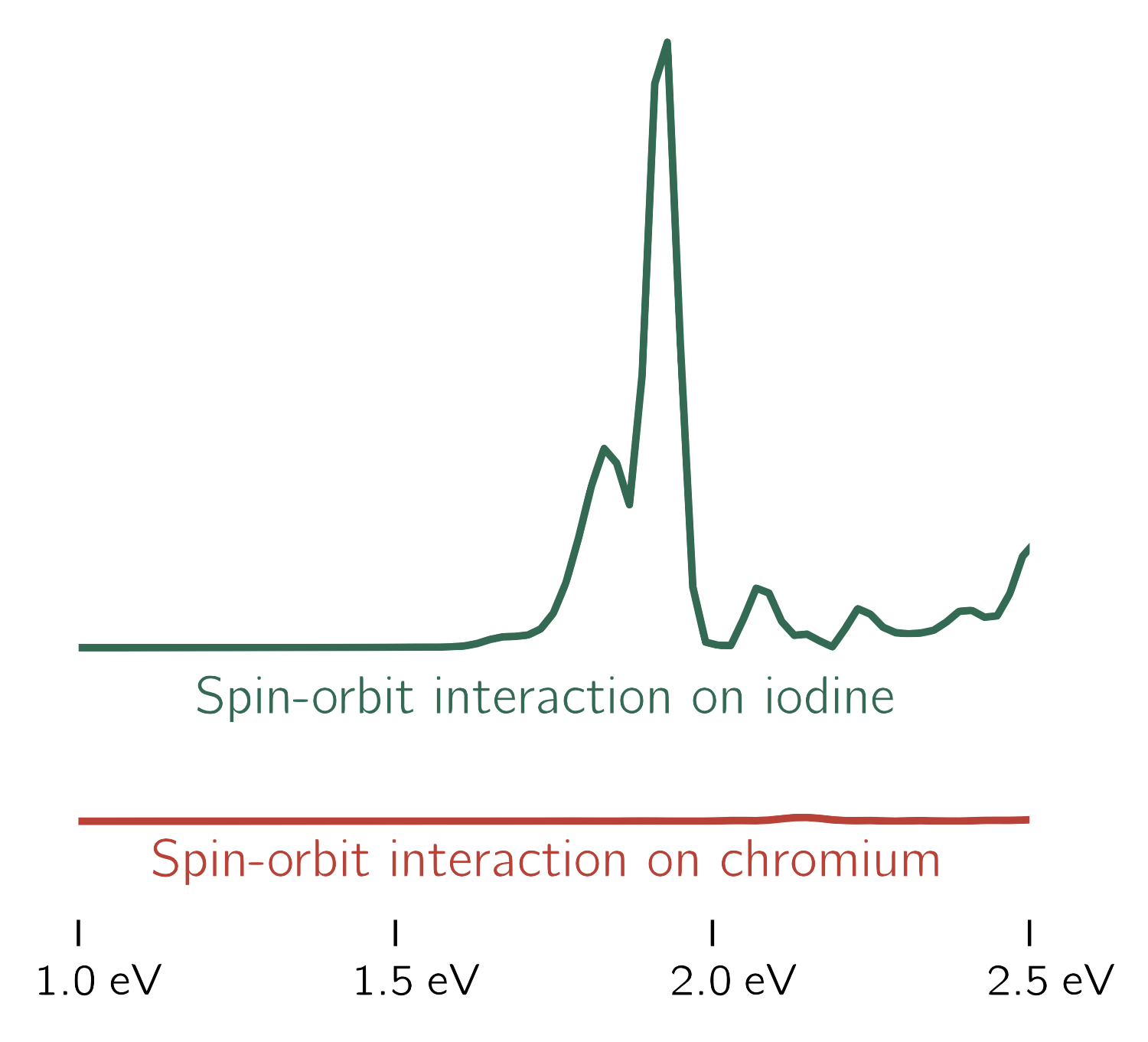 We find unusually large cross-polarized Raman signature of Ag phonon mode in CrI3, in agreement with experiments. The signal is present only when the following three effects are considered in concert: ferromagnetism on Cr atoms, spin-orbit interaction, and resonant effects. Somewhat surprisingly, we find that the relevant spin-orbit interaction potential originates from iodine atoms (see above), despite magnetism being mostly on chromium atoms.
We find unusually large cross-polarized Raman signature of Ag phonon mode in CrI3, in agreement with experiments. The signal is present only when the following three effects are considered in concert: ferromagnetism on Cr atoms, spin-orbit interaction, and resonant effects. Somewhat surprisingly, we find that the relevant spin-orbit interaction potential originates from iodine atoms (see above), despite magnetism being mostly on chromium atoms.
41. Phys. Rev. Materials 5, 025202 (2021) We show that when TiO2 anatase (001) is exposed to hydrogen plasma that the pristine surface (black line) termination becomes unfavorable to another, slightly modified, surface (red line). On this modified surface the topmost TiO2 layer is intact but out of registry with the bottom layers. Nevertheless, the modified surface has significantly improved ability to split water under exposure to sunlight. We show by explicit calculation (see above) of the water splitting reaction that the energy barrier that exists on a pristine surface is not present on the modified surface (blue circle above).
We show that when TiO2 anatase (001) is exposed to hydrogen plasma that the pristine surface (black line) termination becomes unfavorable to another, slightly modified, surface (red line). On this modified surface the topmost TiO2 layer is intact but out of registry with the bottom layers. Nevertheless, the modified surface has significantly improved ability to split water under exposure to sunlight. We show by explicit calculation (see above) of the water splitting reaction that the energy barrier that exists on a pristine surface is not present on the modified surface (blue circle above).
39. Phys. Rev. Materials 4, 075801 (2020)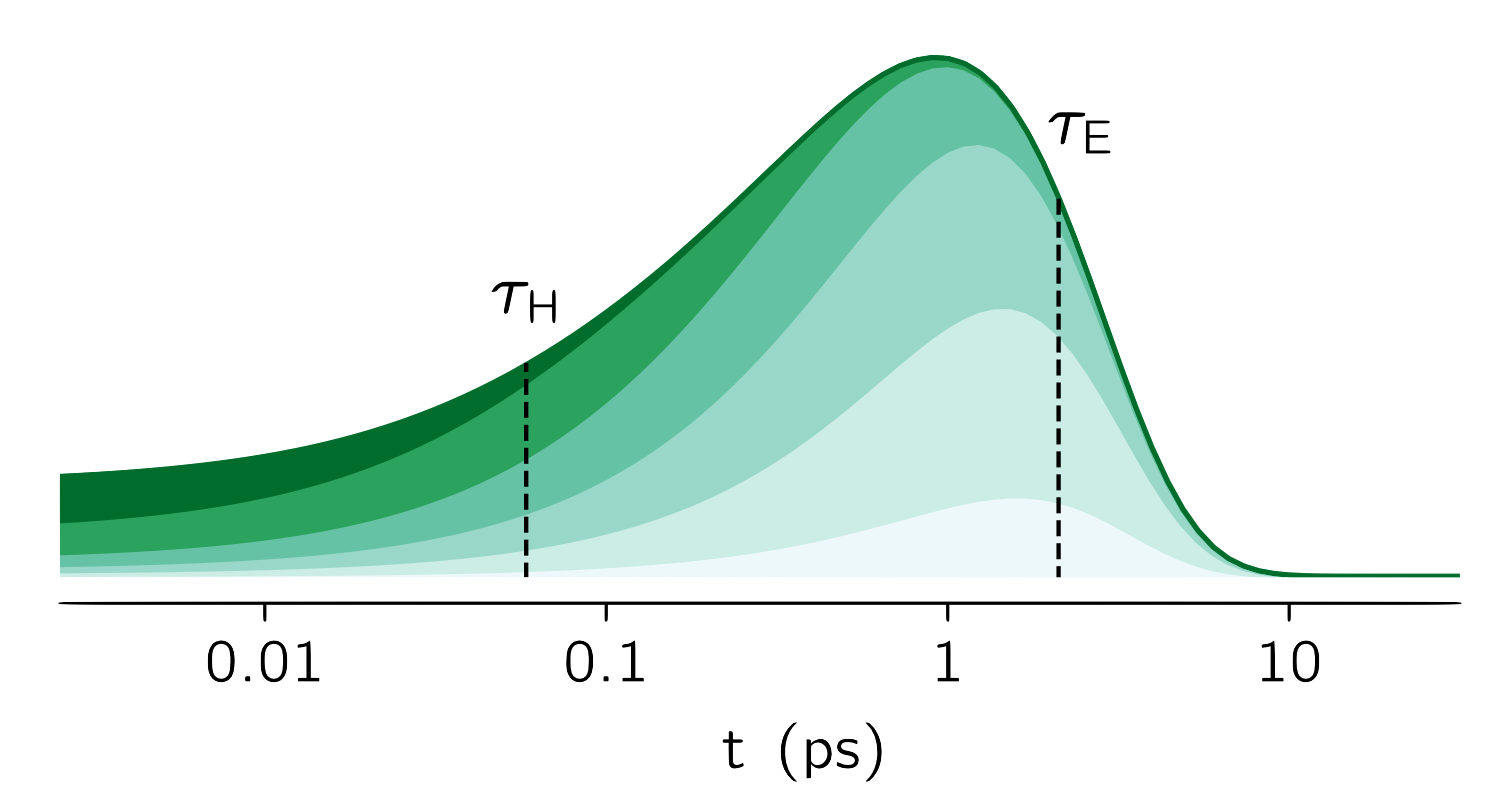 We report simple expressions that capture the interplay of e-e and e-p interactions on electron distribution relaxation times. We observe a dependence of the dynamics on e-e and e-p interaction strengths that is universal to most metals and is also counterintuitive. While only e-p interactions reduce the total energy stored by excited electrons, the time for energy to leave the electronic subsystem also depends on e-e interaction strengths because e-e interactions increase the number of electrons emitting phonons.
We report simple expressions that capture the interplay of e-e and e-p interactions on electron distribution relaxation times. We observe a dependence of the dynamics on e-e and e-p interaction strengths that is universal to most metals and is also counterintuitive. While only e-p interactions reduce the total energy stored by excited electrons, the time for energy to leave the electronic subsystem also depends on e-e interaction strengths because e-e interactions increase the number of electrons emitting phonons.
38. Commun. Phys. 3, 179 (2020)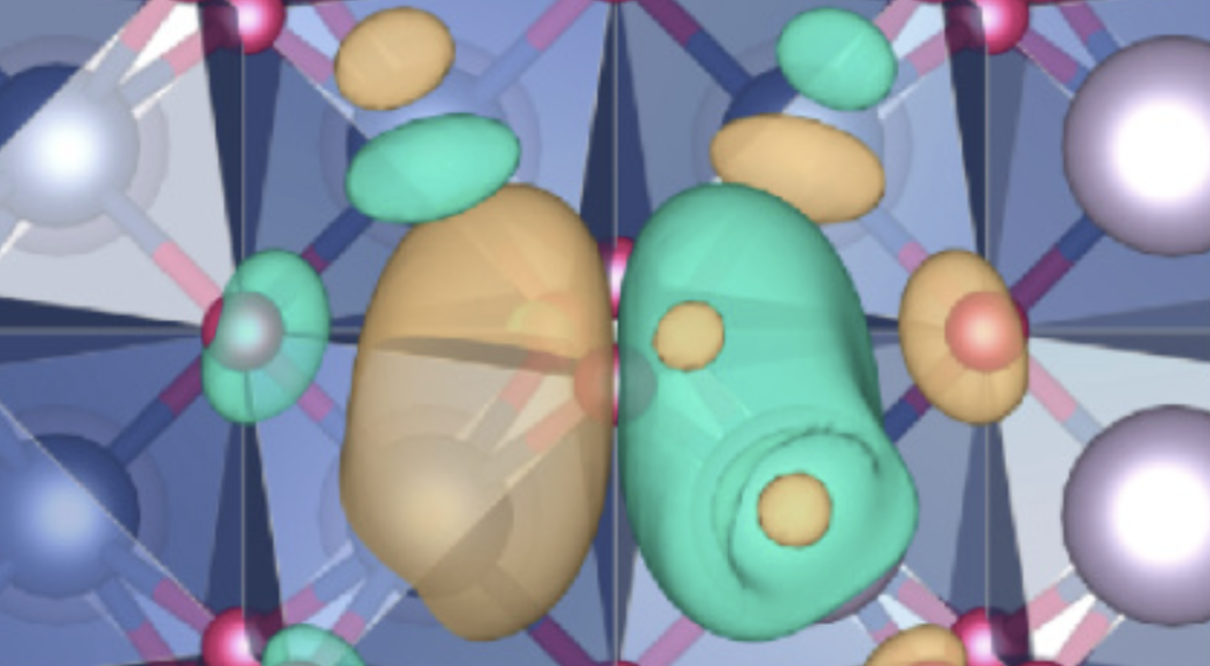 We extract a variable X from electron orbitals Psi_nk and energies E_nk in the parent high-symmetry structure of a wide range of complex oxides. Even though calculation was done only in the parent structure, with no distortions, we show that X dictates material's true ground-state structure.
We extract a variable X from electron orbitals Psi_nk and energies E_nk in the parent high-symmetry structure of a wide range of complex oxides. Even though calculation was done only in the parent structure, with no distortions, we show that X dictates material's true ground-state structure.
33. Phys. Rev. Materials 2, 053606 (2018)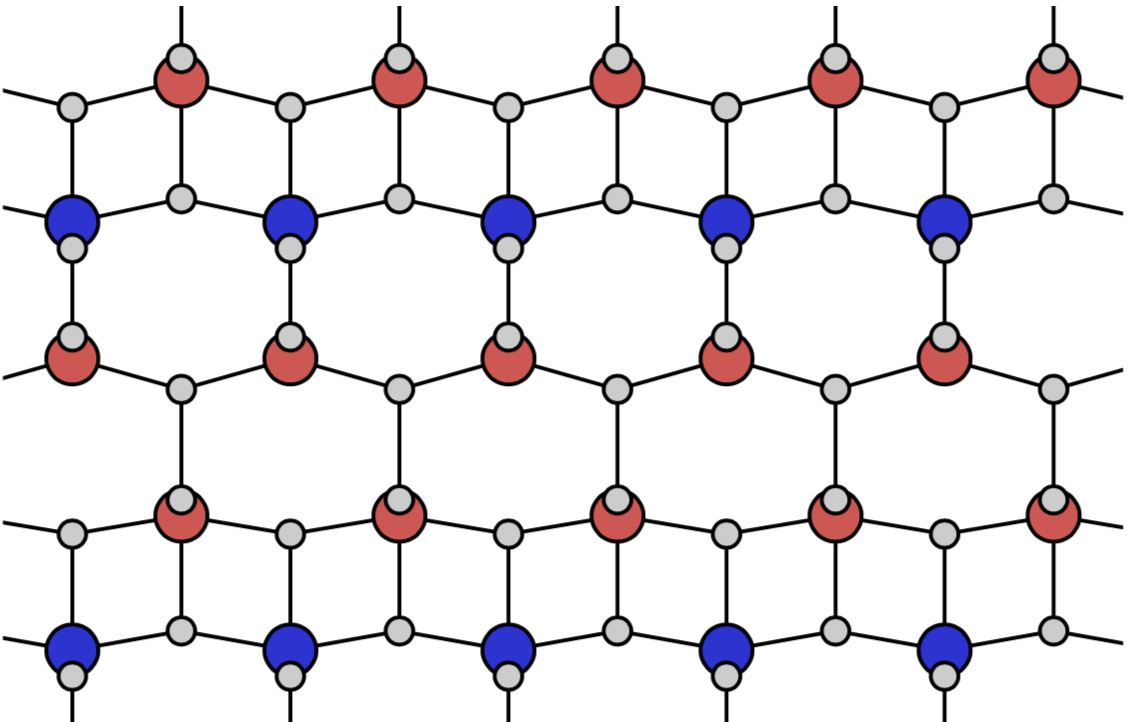 We propose an alternative structure of TiO2 anatase that has a higher energy oxygen p-like valence band maximum than pristine TiO2 anatase and thus has a much better alignment with the water splitting levels. This alternative structure is unique when considering a large subspace of possible structural distortions of TiO2 anatase.
We propose an alternative structure of TiO2 anatase that has a higher energy oxygen p-like valence band maximum than pristine TiO2 anatase and thus has a much better alignment with the water splitting levels. This alternative structure is unique when considering a large subspace of possible structural distortions of TiO2 anatase.
31. Phys. Rev. B 95, 085422 (2017) We show that an optimized projection functions method can automatically construct maximally localized Wannier functions even for bands with nontrivial topology. The resulting Wannier functions contain large imaginary components and are more extended than those in the topologically trivial phase.
We show that an optimized projection functions method can automatically construct maximally localized Wannier functions even for bands with nontrivial topology. The resulting Wannier functions contain large imaginary components and are more extended than those in the topologically trivial phase.
29. Phys. Rev. B 94, 125151 (2016)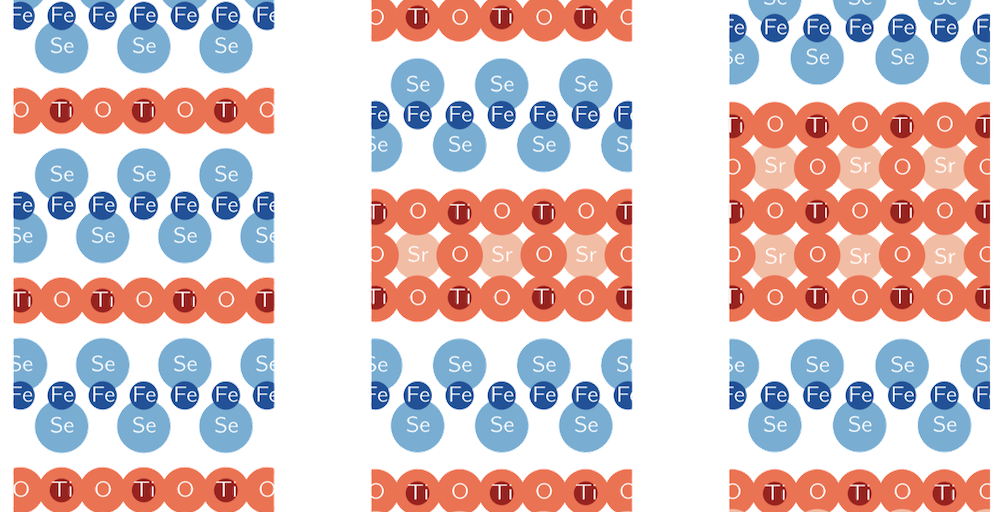 Motivated by the high superconducting transition temperature of monolayer FeSe on SrTiO3, we propose a potential three-dimensional high-temperature superconductor superlattice FeSe-SrTiO3 and study its structural stability and electronic structure.
Motivated by the high superconducting transition temperature of monolayer FeSe on SrTiO3, we propose a potential three-dimensional high-temperature superconductor superlattice FeSe-SrTiO3 and study its structural stability and electronic structure.
27. Phys. Rev. B 93, 245138 (2016)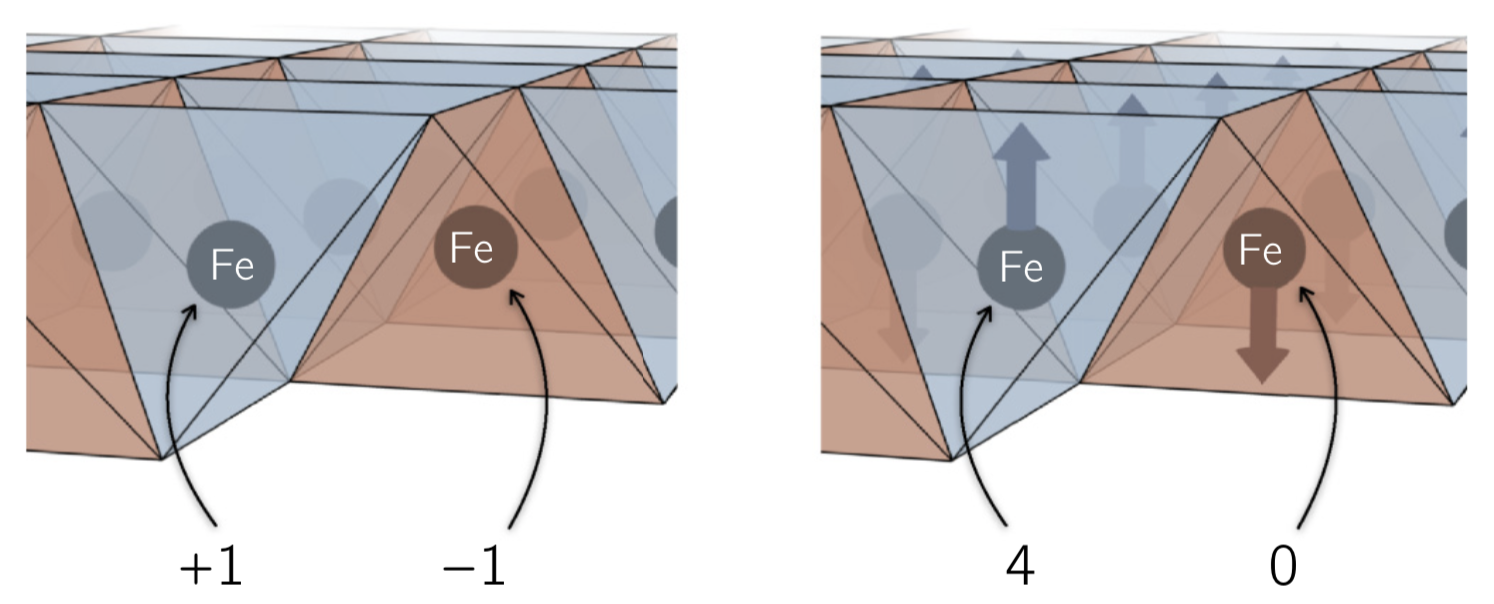 It is shown that a generic form of an antiferromagnetic wave function opens strong electron-phonon coupling channels in the iron-based superconductors. In the nonmagnetic state these channels exist locally on a single iron atom but are canceled out between the two iron atoms in the primitive unit cell.
It is shown that a generic form of an antiferromagnetic wave function opens strong electron-phonon coupling channels in the iron-based superconductors. In the nonmagnetic state these channels exist locally on a single iron atom but are canceled out between the two iron atoms in the primitive unit cell.
24. Phys. Rev. B 94, 104505 (2016) We show that electron-phonon coupling can induce strong electron pairing in an FeSe monolayer on a SrTiO3 substrate.
We show that electron-phonon coupling can induce strong electron pairing in an FeSe monolayer on a SrTiO3 substrate.
19. New J. Phys. 17 (2015) 073027 We have performed a systematic representation-theory-based search for the simplest structures allowing isotropic magnetoelectric coupling. We found 44 such structures, all sharing a common pattern of atomic displacements in the direction of atomic magnetic moments.
We have performed a systematic representation-theory-based search for the simplest structures allowing isotropic magnetoelectric coupling. We found 44 such structures, all sharing a common pattern of atomic displacements in the direction of atomic magnetic moments.
16. Phys. Rev. B 88, 121106(R) (2013)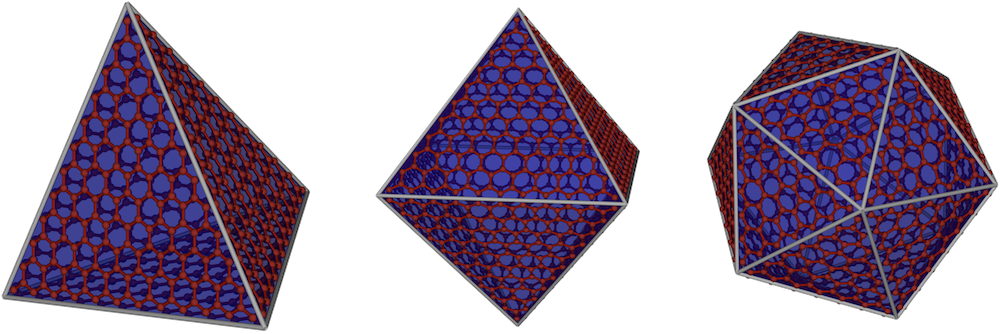 We study topologically nontrivial electronic structure of topological fullerenes or other closed-cage molecules.
We study topologically nontrivial electronic structure of topological fullerenes or other closed-cage molecules.
15. Phys. Rev. B 88, 155127 (2013) We find particularly strong modifications to the Raman signal of graphene on platinum, compared to that of suspended graphene. The modifications strongly depend on the relative orientation of the graphene and platinum lattices.
We find particularly strong modifications to the Raman signal of graphene on platinum, compared to that of suspended graphene. The modifications strongly depend on the relative orientation of the graphene and platinum lattices.
14. Phys. Rev. B 88, 235431 (2013)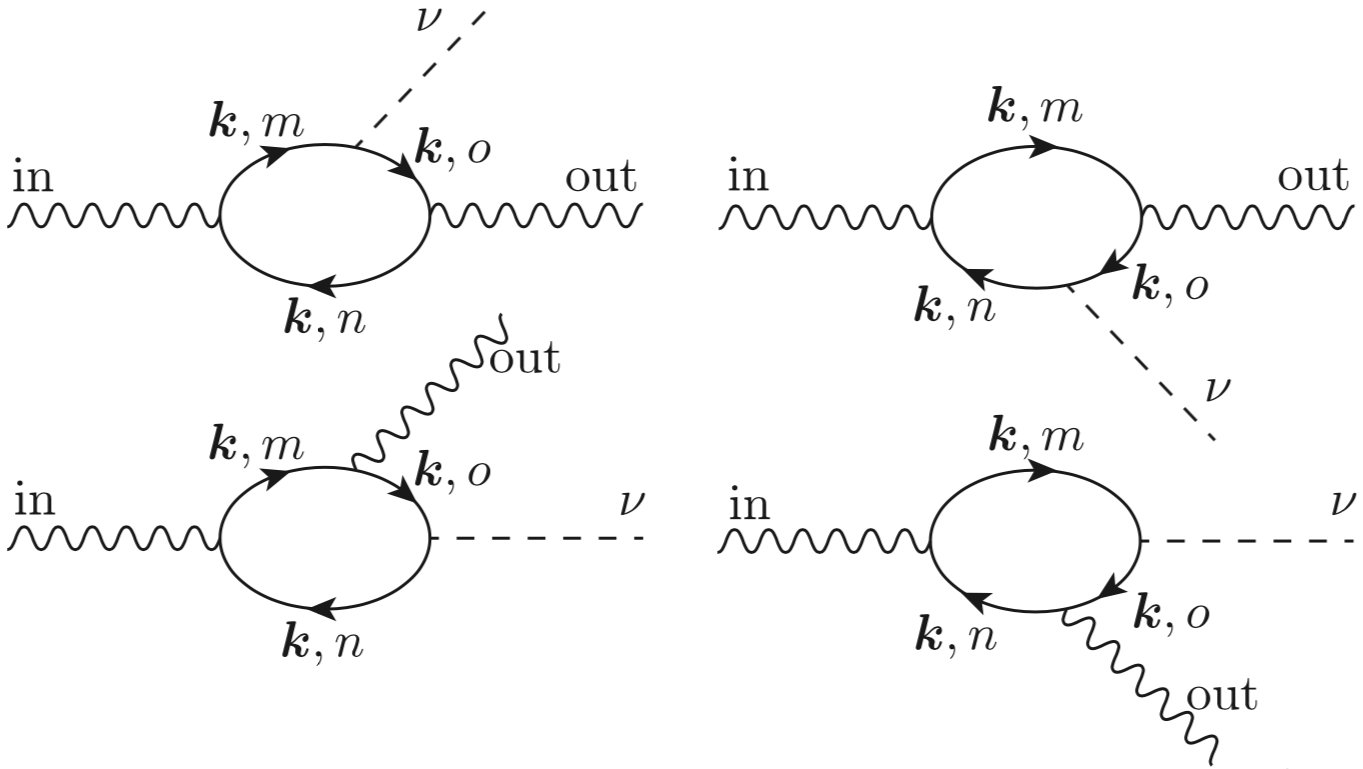 We study theoretically the Raman spectrum of the rotated (twisted) double-layer graphene, consisting of two graphene layers rotated with respect to each other by an arbitrary angle theta.
We study theoretically the Raman spectrum of the rotated (twisted) double-layer graphene, consisting of two graphene layers rotated with respect to each other by an arbitrary angle theta.
11. Phys. Rev. B 88, 165431 (2013)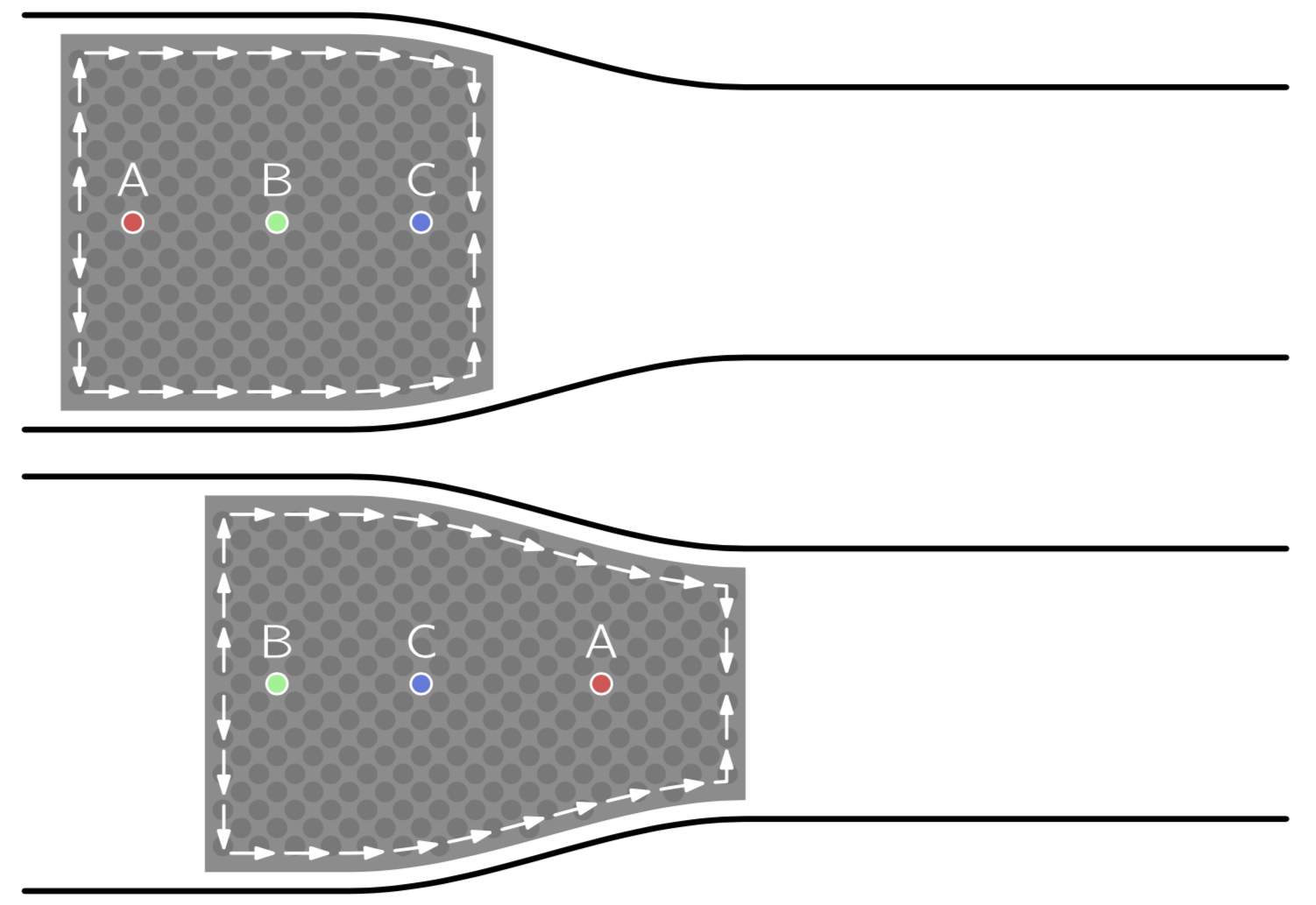 Under the application of electrical currents, metal nanocrystals inside carbon nanotubes can be bodily transported. We examine how an iron nanocrystal can pass through a constriction in the carbon nanotube with a smaller cross-sectional area than the nanocrystal itself.
Under the application of electrical currents, metal nanocrystals inside carbon nanotubes can be bodily transported. We examine how an iron nanocrystal can pass through a constriction in the carbon nanotube with a smaller cross-sectional area than the nanocrystal itself.
10. Phys. Rev. Lett. 110, 185901 (2013)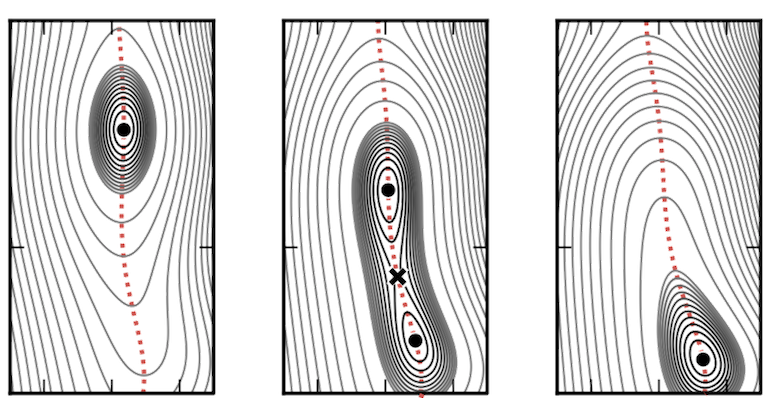 Using first-principles density functional theory calculations, we discover an anomalously large biaxial strain-induced octahedral rotation axis reorientation in orthorhombic perovskites with tendency towards rhombohedral symmetry.
Using first-principles density functional theory calculations, we discover an anomalously large biaxial strain-induced octahedral rotation axis reorientation in orthorhombic perovskites with tendency towards rhombohedral symmetry.
6. Phys. Rev. Lett. 106, 235502 (2011) We present a Wannier-based method to calculate the Chern-Simons orbital magnetoelectric coupling in the framework of first-principles density-functional theory. We anticipate that the Chern-Simons contribution to the magnetoelectric coupling could, in special cases, be as large or larger than the total magnetoelectric coupling in known magnetoelectrics, such as Cr2O3.
We present a Wannier-based method to calculate the Chern-Simons orbital magnetoelectric coupling in the framework of first-principles density-functional theory. We anticipate that the Chern-Simons contribution to the magnetoelectric coupling could, in special cases, be as large or larger than the total magnetoelectric coupling in known magnetoelectrics, such as Cr2O3.
5. Phys. Rev. B 83, 085108 (2011)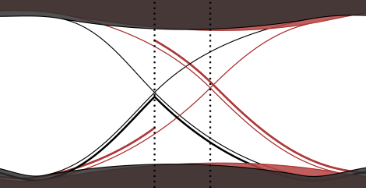 We extend the Berry-phase concept of polarization to insulators having a nonzero value of the Chern invariant.
We extend the Berry-phase concept of polarization to insulators having a nonzero value of the Chern invariant.
2. Phys. Rev. Lett. 102, 107603 (2009)
Among the phases of SiO2 are alpha and beta cristobalites, which have a long and somewhat controversial history of proposed structural assignments and phase-transition mechanisms. We use first-principles calculations to investigate the energy, structure, and local stability of P4_12_12 and I-42d structures.
1. Phys. Rev. B 78, 054117 (2008)
55. Kevin Moseni, Richard B. Wilson, Sinisa Coh
"Electron-phonon coupling in ferromagnetic Fe-Co alloys from first principles"
Phys. Rev. Materials 8, 114425 (2024).
[PDF] [journal] [arXiv] [supplement]
54. Kevin Moseni, Sinisa Coh
"Orbital magnetization of a metal is not a bulk property in the mesoscopic regime"
Phys. Rev. B 109, 174431 (2024).
[PDF] [journal] [arXiv] [supplement code] [supplement pdf]
53. Mohammed Alghamdi, Palani R. Jothi, Wei-Cheng Liao, Sinisa Coh, Xianqing Lin, Boniface P.T. Fokwa, Jing Shi
"Layer-dependence study of two-dimensional ferromagnets: Fe3GeTe2 and Fe5Ge2Te2"
Appl. Phys. Lett. 124, 192404 (2024).
52. Ming Lei, Sinisa Coh
"Terahertz magneto-optical response in ferromagnetic Fe-Co-Al alloys"
J. Phys.: Condens. Matter 36 315504 (2024).
51. Victor H. Ortiz, Shashi B. Mishra, Luat Vuong, Sinisa Coh, Richard B. Wilson
"Specular inverse Faraday effect in transition metals"
Phys. Rev. Materials 7, 125202 (2023).
50. Shashi B. Mishra, Sinisa Coh
"Spin contribution to the inverse Faraday effect of non-magnetic metals"
Phys. Rev. B 107, 214432 (2023).
49. John Bonini, Shang Ren, David Vanderbilt, Massimiliano Stengel, Cyrus E. Dreyer, Sinisa Coh
"Frequency splitting of chiral phonons from broken time reversal symmetry in CrI3"
Phys. Rev. Lett. 130, 086701 (2023).
48. Sinisa Coh
"Classification of materials with phonon angular momentum and microscopic origin of angular momentum"
Phys. Rev. B 108, 134307 (2023).
47. Victor H. Ortiz, Sinisa Coh, Richard B. Wilson
"Magneto-optical Kerr spectra of gold induced by spin accumulation"
Phys. Rev. B 106, 014410 (2022).
[PDF] [journal] [arXiv] [supplement]
46. Ramya Mohan, Victor H. Ortiz, Luat Vuong, Sinisa Coh, Richard B. Wilson
"Electron-Phonon Scattering governs both Ultrafast and Precessional Magnetization Dynamics in Co-Fe Alloys"
Submitted.
45. Kevin Moseni, Richard B. Wilson, Sinisa Coh
"Electric field control of phonon angular momentum in perovskite BaTiO3"
Phys. Rev. Materials 6, 104410 (2022).
[PDF] [journal] [arXiv] [supplement code]
44. Cyrus E. Dreyer, Sinisa Coh, Massimiliano Stengel
"Nonadiabatic Born effective charges in metals and the Drude weight"
Phys. Rev. Lett. 128, 095901 (2022).
[PDF] [journal] [arXiv] [supplement]
43. Paul Anderson, Yifan Huang, Yuanjun Fan, Sara Qubbaj, Sinisa Coh, Qin Zhou, Claudia Ojeda-Aristizabal
"Strain-tuning of domain walls in multilayer graphene probed in the quantum Hall regime"
Phys. Rev. B 105, L081408 (2022).
42. Kexin Liu, Xinping Shi, Frank Angeles, Ramya Mohan, Jon Gorchon, Sinisa Coh, Richard B. Wilson
"Differentiating contributions of electrons and phonons to the thermoreflectance spectra of gold"
Phys. Rev. Materials 5, 106001 (2021).
[PDF] [journal] [arXiv] [supplement]
41. Ming Lei, Sinisa Coh
"Large cross-polarized Raman signal in CrI3: A first-principles study"
Phys. Rev. Materials 5, 025202 (2021).
[PDF] [journal] [arXiv] [supplement 1] [supplement 2]
40. Hyounmyung Park, Eunsoo Lee, Ming Lei, Hyunkeun Joo, Sinisa Coh, Boniface Fokwa
"Canonic-like HER activity of Cr1-xMoxB2 Solid Solution: Overpowering Pt/C at high current density"
Adv. Mater. 2020, 32, 2000855.
39. Ming Lei, Sinisa Coh
"Hydrogen plasma favored modification of anatase TiO2 (001) surface with desirable water splitting performance"
Phys. Rev. Materials 4, 075801 (2020).
38. Richard B. Wilson, Sinisa Coh
"Parametric dependence of hot electron relaxation timescales on electron-electron and electron-phonon interaction strengths"
Commun. Phys. 3, 179 (2020).
[PDF] [arXiv] [journal] [supplement] [video 1] [video 2]
37. Diana Y. Qiu, Sinisa Coh, Marvin L. Cohen, Steven G. Louie
"Comparison of GW band structure to semi-empirical approach for an FeSe monolayer"
Phys. Rev. B 101, 235154 (2020).
36. Bradford A. Barker, Aaron J. Bradley, Miguel Moreno Ugeda, Sinisa Coh, Alex Zettl, Michael F. Crommie, Steven G. Louie, Marvin L. Cohen
"The Geometry and Electronic Structure of Iridium adsorbed on Graphene"
Phys. Rev. B 99, 075431 (2019).
35. Yuta Aoki, Masahiro Sakurai, Sinisa Coh, James R. Chelikowsky, Steven G. Louie, Marvin L. Cohen, Susumu Saito
"Insulating titanium oxynitride for visible light photocatalysis"
Phys. Rev. B 99, 075203 (2019).
34. Zhisheng Lin, Mark Lohmann, Zulfikhar Ali, Chi Tang, Junxue Li, Wenyu Xing, Jiangnan Zhong, Shuang Jia, Wei Han, Sinisa Coh, Ward Beyermann, Jing Shi
"Pressure-induced spin reorientation transition in layered ferromagnetic insulator Cr2Ge2Te6"
Phys. Rev. Materials 2, 051004(R) (2018).
33. Nicholas Rajen, Sinisa Coh
"What can one learn about material structure given a single first-principles calculation?"
Phys. Rev. Materials 2, 053606 (2018).
32. Chin Shen Ong, Sinisa Coh, Marvin L. Cohen, Steven G. Louie
"Real-space study of the optical absorption in alternative phases of silicon"
Phys. Rev. Materials 1, 075408 (2017).
31. Sinisa Coh, Peter Y. Yu, Yuta Aoki, Susumu Saito, Steven G. Louie, Marvin L. Cohen
"Alternative structure of TiO2 with higher energy valence band edge"
Phys. Rev. B 95, 085422 (2017).
30. Ashley M. Cook, Benjamin M. Fregoso, Fernando de Juan, Sinisa Coh, Joel E. Moore
"Design principles for shift current photovoltaics"
Nature Communications 8, 14176 (2017).
29. Jamal I. Mustafa, Sinisa Coh, Marvin L. Cohen, Steven G. Louie
"Automated construction of maximally localized Wannier functions for bands with nontrivial topology"
Phys. Rev. B 94, 125151 (2016).
28. Hamid Reza Barzegar, Aiming Yan, Sinisa Coh, Eduardo Gracia-Espino, Gabriel Dunn, Thomas Wagberg, Steven G. Louie, Marvin L. Cohen, Alex Zettl
"Electrostatically Driven Nanoballoon Actuator"
Nano Lett., 2016, 16 (11), pp 6787-6791.
27. Sinisa Coh, Dung-Hai Lee, Steven G. Louie, Marvin L. Cohen
"Proposal for a bulk material based on a monolayer FeSe on SrTiO3 high temperature superconductor"
Phys. Rev. B 93, 245138 (2016).
26. Hyungju Oh, Sinisa Coh, Young-Woo Son, Marvin L. Cohen
"Inhibiting Klein tunneling in graphene p-n junction without an external magnetic field"
Phys. Rev. Lett. 117, 016804 (2016).
25. Hamid Reza Barzegar, Aiming Yan, Sinisa Coh, Eduardo Gracia-Espino, Claudia Ojeda-Aristizabal, Gabriel Dunn, Marvin L. Cohen, Steven G. Louie, Thomas Wagberg, Alex Zettl
"Spontaneous twisting of a collapsed carbon nanotube"
Nano Res. June 2017, Volume 10, Issue 6, pp 1942-1949.
24. Sinisa Coh, Marvin L. Cohen, Steven G. Louie
"Antiferromagnetism enables electron-phonon coupling in iron-based superconductors"
Phys. Rev. B 94, 104505 (2016).
23. Hsin-Zon Tsai, Arash A. Omrani, Sinisa Coh, Hyungju Oh, Sebastian Wickenburg, Young-Woo Son, Dillon Wong, Alexander Riss, Han Sae Jung, Giang D. Nguyen, Griffin F. Rodgers, Andrew S. Aikawa, Takashi Taniguchi, Kenji Watanabe, Alex Zettl, Steven G. Louie, Jiong Lu, Marvin L. Cohen, Michael F. Crommie
"Molecular self-assembly in a poorly screened environment: F4TCNQ on graphene/BN"
ACS Nano, 2015, 9 (12), 12168-12173.
22. Jamal I. Mustafa, Sinisa Coh, Marvin L. Cohen, Steven G. Louie
"Automated construction of maximally localized Wannier functions: the optimized projection functions (OPF) method"
Phys. Rev. B 92, 165134 (2015).
21. Hyungju Oh, Sinisa Coh, Marvin L. Cohen
"Calculation of the specific heat of optimally K-doped BaFe2As2"
J. Phys.: Condens. Matter 27 (2015) 335504.
20. Benjamin M. Fregoso, Sinisa Coh
"Intrinsic surface dipole in topological insulators"
J. Phys.: Condens. Matter 27 (2015) 422001.
19. Sinisa Coh, Steven G. Louie, Marvin L. Cohen
"Large electron-phonon interactions from FeSe phonons in a monolayer"
New J. Phys. 17 (2015) 073027.
18. Timur Bazhirov, Sinisa Coh, Steven G. Louie, Marvin L. Cohen
"Importance of oxygen octahedra tilts for the electron-phonon coupling in K-doped BaBiO3"
Phys. Rev. B 88, 224509 (2013).
17. Yuki Sakai, Giang D. Nguyen, Rodrigo B. Capaz, Sinisa Coh, Ivan V. Pechenezhskiy, Xiaoping Hong, Feng Wang, Michael F. Crommie, Susumu Saito, Steven G. Louie, Marvin L. Cohen
"Intermolecular interactions and substrate effects for an adamantane monolayer on a Au(111) surface"
Phys. Rev. B 88, 235407 (2013).
16. Sinisa Coh, David Vanderbilt
"Canonical magnetic insulators with isotropic magnetoelectric coupling"
Phys. Rev. B 88, 121106(R) (2013).
[PDF] [journal] [arXiv] [erratum] [supplement]
15. Andreas Ruegg, Sinisa Coh, Joel E. Moore
"Corner states of topological fullerenes"
Phys. Rev. B 88, 155127 (2013).
14. Qin Zhou, Sinisa Coh, Marvin L. Cohen, Steven G. Louie, A. Zettl
"Imprint of transition metal d-orbitals on a graphene Dirac cone"
Phys. Rev. B 88, 235431 (2013).
13. Kwanpyo Kim, Sinisa Coh, C. Kisielowski, M. F. Crommie, Steven G. Louie, Marvin L. Cohen, A. Zettl
"Atomically perfect torn graphene edges and their reversible reconstruction"
Nature Communications 4, 2723 (2013).
12. Sinisa Coh, Steven G. Louie, Marvin L. Cohen
"Theoretical study of solid iron nanocrystal movement inside a carbon nanotube"
Phys. Rev. B 88, 045424 (2013).
11. Sinisa Coh, Liang Z. Tan, Steven G. Louie, Marvin L. Cohen
"Theory of the Raman spectrum of the rotated double-layer graphene"
Phys. Rev. B 88, 165431 (2013).
10. Sinisa Coh, Will Gannett, A. Zettl, Marvin L. Cohen, Steven G. Louie
"Surface Atom Motion to Move Iron Nanocrystals through Constrictions in Carbon Nanotubes under the Action of an Electric Current"
Phys. Rev. Lett. 110, 185901 (2013).
[PDF] [journal] [synopsis] [arXiv] [science news] [physicsworld] [new scientist]
9. Andrei Malashevich, Sinisa Coh, Ivo Souza, David Vanderbilt
"Full magnetoelectric response of Cr2O3 from first principles"
Phys. Rev. B 86, 094430 (2012).
8. T. E. Glover, D. M. Fritz, M. Cammarata, T. K. Allison, Sinisa Coh, J. M. Feldkamp, H. Lemke, D. Zhu, Y. Feng, R. N. Coffee, M. Fuchs, S. Ghimire, J. Chen, S. Shwartz, D. A. Reis, S. E. Harris, J. B. Hastings
"X-ray and optical wave mixing"
Nature 488, 603 (2012).
[journal] [synopsis] [supplement]
7. Kwanpyo Kim, Sinisa Coh, Liang Z. Tan, William Regan, Jong Min Yuk, Eric Chatterjee, M. F. Crommie, Marvin L. Cohen, Steven G. Louie, A. Zettl
"Raman spectroscopy study of rotated double-layer graphene: misorientation angle dependence of electronic structure"
Phys. Rev. Lett. 108, 246103 (2012).
[PDF] [journal] [synopsis] [arXiv] [supplement]
6. James M. Rondinelli, Sinisa Coh
"Large isosymmetric reorientation of oxygen octahedra rotation axes in epitaxially strained perovskites"
Phys. Rev. Lett. 106, 235502 (2011).
5. Sinisa Coh, David Vanderbilt, Andrei Malashevich, Ivo Souza
"Chern-Simons orbital magnetoelectric coupling in generic insulators"
Phys. Rev. B 83, 085108 (2011).
4. Sinisa Coh, Tassilo Heeg, J.H. Haeni, M.D. Biegalski, J. Lettieri, L.F. Edge, K.E. O'Brien, M. Bernhagen, P. Reiche, R. Uecker, S. Trolier-McKinstry, Darrell G. Schlom, David Vanderbilt
"Si-compatible candidates for high-K dielectrics with the Pbnm perovskite structure"
Phys. Rev. B 82, 064101 (2010).
[PDF] [journal] [arXiv] [supplement]
3. Andrei Malashevich, Ivo Souza, Sinisa Coh, David Vanderbilt
"Theory of orbital magnetoelectric response"
New J. Phys. 12, 053032 (2010).
2. Sinisa Coh, David Vanderbilt
"Electric polarization in a Chern insulator"
Phys. Rev. Lett. 102, 107603 (2009).
1. Sinisa Coh, David Vanderbilt
"Structural stability and lattice dynamics of SiO2 cristobalite"
Phys. Rev. B 78, 054117 (2008).
[PDF] [journal] [arXiv] [supplementary video]
Ph.D. Thesis
Sinisa Coh, "Electronic structure theory: applications and geometrical aspects"
Rutgers, The State University of New Jersey (2011).
[PDF]
Software
Wavefunction database and computation (WfBase)
WfBase is a software package providing an easy way to compute from first-principles various properties depending on the electronic structure of periodic solids. This package can parse user-provided mathematical expressions, in a human-readable format, using the Einstein notation for indices. It is well suited, for example, to calculate terms that arise in the perturbation theory context, where one needs to sum over electronic states over arbitrarily dense sampling of the Brillouin zone.
Python Tight Binding (PythTB)
PythTB is a software package providing a Python implementation of the tight-binding approximation. It can be used to construct and solve tight-binding models of the electronic structure of systems of arbitrary dimensionality (crystals, slabs, ribbons, clusters, etc.), and is rich with features for computing Berry phases and related properties.